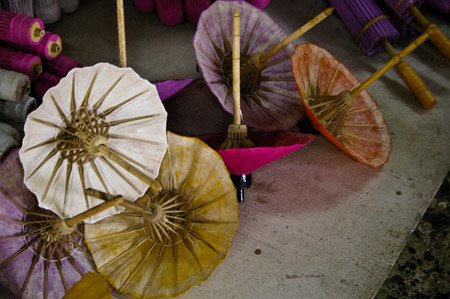
Paper Umbrellas and Objects
Here is a small collection of paper cocktail umbrellas, shot in Thailand by Yan Pritzker. Let’s say at an outdoor bar on some beach, the bartender asks your niece to pick the paper umbrella she wants for her Shirley Temple. Instead of one, she opens them all. He’s delighted. She keeps the yellow one and plays with it on the plane home. It reminds you of the shallow waves, the coconut smell of sunscreen. And then it reminds you of the first boyfriend you ever had. You were eight years old. You sat under a bright canvas umbrella in his backyard and it was raining. You think it was raining. All you can recall for sure is your charged sensation of being attracted in a romantic way for the very first time.
Objects can carry sense information and memories. Some of us are more sensitive to this than others in our real lives. But in our writing, we can all learn to use this ability objects have to convey meaning. This can be very useful.
First, we find an object that correlates to an emotion in the life of one of our characters. It can be iconic, like a crucifix, diploma, wedding ring. Or it can be ordinary, like a dog leash. We write the scene that establishes a correlation between the object and the feeling. We give the object a tiny role in our story.
We can use objects in every single writing form, whether mystery, sci-fi, historical fiction, academic work, memoir. The use of an object isn’t a fundamental aspect of writing, but it’s a great accessory in our wardrobe. Not a suit but a great tie!
We can also do more by giving the object its own plot line so that it mirrors the emotions that change in our character over time. We don’t tell the reader about the change. We show it by having the character interact with the object over time, arousing new feelings at the end that were not present at the outset. As in the paragraph above. This can be very powerful in our work and very beautiful.
We can tell our entire story through the lens of a single object. A set of car keys given to a teenager, is removed from his crashed car, then placed in the pocket of the black suit worn by his father at his son’s funeral. The keys correlate to grief, maybe anger, remorse, maybe guilt, maybe memory of the early optimism the day he and his wife gave the keys to their son.
Twenty-eight years later the same father comes across the keys in the back of his socks drawer. He notices the quite unforeseeable fact that his grief did not destroy him or his marriage, but by some force he has no name for, his grief has finally become something else. Something good, strong, new and promising. He almost calls it joy.
Exercise
1. Take an object you love– a mountain bike, hair clip, a well-designed can opener. Give it a plot line. Have it appear 3 times in your story, whether you’re writing a 500 word flash piece, a 300 page memoir, a brief self-help book, a treatise. Have your character react differently to it each time it appears. Make an arc. Write out 3 moments. Sit with your rough draft and have fun placing these among what you already have. See what happens.
If you just started writing last week and, of course, are nowhere near having a draft, just do the exercises and make a note to yourself about this correlation. Save all that you’ve done. You’ll figure it all out later, when the time comes.
Contact maryrakow1@gmail.com
©Mary Rakow, 2023. Please do not reproduce without written permission from the author.